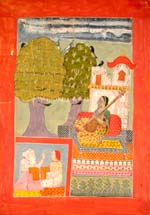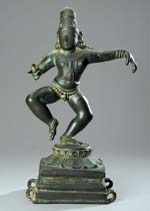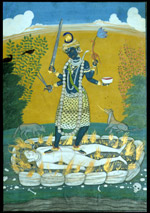2016 Art Appreciation Essay Contest
The next Art Appreciation Contest sponsored by The Committee for the Arts of the Indian Subcontinent (CAIS) will be in the fall 2016. High school students will be invited to view pieces of art at The San Diego Museum of Art and give a written response to what they see. The current South Asian, Southeast Asian, and Persian Art galleries (9-11) will close in May, 2016 and reopen in the fall in the north side of galleries 12 and 13. The contestants will have a tour of the new galleries led by a CAIS member. In the past, Contest entries have been judged by Robert Pincus, San Diego Union-Tribune art critic, Derrick Cartwright, University of San Diego and former Director of The San Diego Museum of Art and other experts. The prize money is donated by one of the CAIS members. Early in 2017, the winners are invited to a CAIS meeting to receive their prizes. After the meeting there is a reception for the winners. If you want to be notified about the Contest, please click to be added to our Contest email list.
Prizes:
First Place – $500
Second Place – $250
Third Place – $100
2014 Third Place Winner: Yunfan Yang, Torrey Pines High School
Gateway to Wonders

Walking through a museum exhibit enthralls the senses; the smells not unlike antediluvian books in ancient libraries calling to be discovered, the soft sounds of shuffling feet, the artifacts, each offering more than meets the eye on a passing glance. A secret world lies in front of us within a museum, though most don’t open the gateway to such wonder. Passing through the exhibit, a painting stops me in my tracks, luring me towards its cleverly concealed treasure in its archaic blends of watercolor. A. woman, delicately portrayed in a grove next to sparkling waters embedded with fragrant lily blossoms, draws my attention away from my map with her careful slanted eyes guarding her treasure within. Her fingers hover above her vina as she pauses to ponder, Aurora’s soft breath washing the hillside with an orchestra of magnificent hues. The remaining sweet notes of harmony dissolve into the cool air, and songbirds begin to sing, symphonizing with sonorous echoes in the valley. The notes of vina and the song of birds join to form a beautiful blend of perfect synchronization between mankind and nature which lies within every rustle in a wind and flit of a shadow. I look over the magnificent view, take in a breath of fresh morning air, hear the dulcet music soaring. Opening my eyes, I’m once more standing in a museum, hands holding a map. I start walking towards the exit, knees numb and hands cold, and smile, knowing that the gateway has been opened.
Winning Essay 2014
Meera Kota, 10th grade, Torrey Pines High School
The Little Dancing Boy

As a long time student of classical Indian dance, the minute I walked into the Temple section of the exhibit, I gravitated instantly toward the sculpture of the dancing boy. This 11th century bronze statue of Sambandar originates from the southern city of Tanjore in Tamil Nadu. Sambandar is described as a child devotee for Lord Shiva, the patron saint of the Indian dance Bharatanatyam. The little boy is dancing to show his devotion to Siva and thinks of the Lord and his consort Parvathi as his parents. The sculpture communicates how excited and happy he is. His closed eyes represent his devotion to his parents and his desire to immerse in them. If you look really close, there was an ever so small smile showing his joy and enthusiasm. His body is bare, except for some jewelry conveying his youth and innocence. His dancing pose is it similar to many depictions of Lord Shiva as “Nataraja”. I was struck by how often I have used the same pose before and also recognize that his left hand is in the Bharatanatyam gesture of “dola hasta”! Sambandar has little anklets which imply that he is young and innocent but has been dancing for a few years already. I am amazed that the art form from a thousand years ago is the same I practice on a daily basis and is relevant even today! It makes me proud of my heritage and validates my effort to keep this ancient dance form alive.
2014 Second Place Winner: Nivaasya Ramachandran, Torrey Pines High School
Kali Stands Masterfully over a Prostrate Shiva

It’s an image that delivered a visceral impact. The wildly beautiful Indian Goddess, scantily clad, laden with jewelry and as heavily with weapons, left me perplexed. Kali looks down with lazy scorn upon Shiva, her head tilted in perverse curiosity, her gaze languishing upon her conquest and her hip cocked carelessly in gloating victory. What gives her the confidence of her superiority over Shiva? Why does it appear that evil is victorious over good?
This nefarious character cannot be a Goddess! A deity is supposed to be merciful, loving, forgiving … one of which is depicted in this representation of Kali. How could anyone pray to her? I couldn’t even relate to her.
But in truth, is it possible for this character to be unfamiliar? As all deities are embodiments of a myriad attributes that we possess within ourselves or observe in others. How can we not recognize what is in essence a supreme form of ourselves? It’s as if I was trying to visualize a new color to decipher the Goddess’ unusual representation.
Reviewing the piece, I would say Kali symbolizes a sheer primal force of protectiveness, like that of a mother’s for her children. If someone we cared for was under threat, we would adopt Kali’s stance of indignant ruthlessness in protecting him or her. For me, the figure of Kali inspires bravery and promotes loyalty.